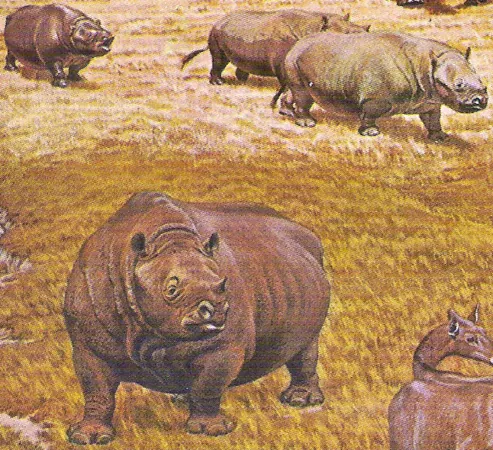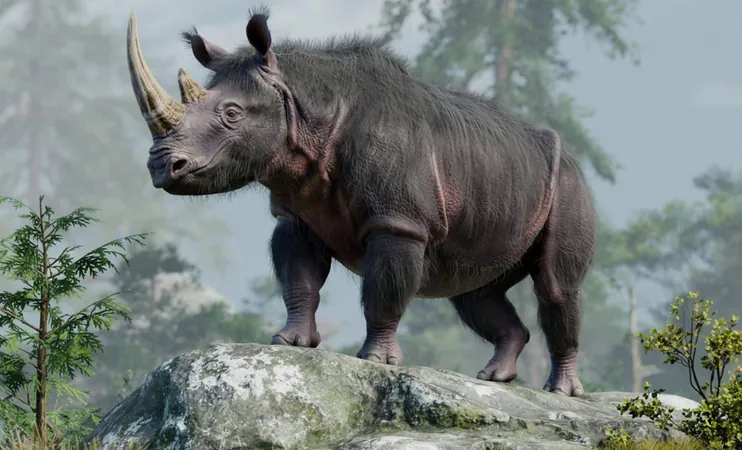
Unraveling the Secrets of North America's Giant Rhinos: The Teleoceras Major
2025-04-09
Author: John Tan
Massive Herds of Extinct Rhinos Unearthed in Nebraska
Paleontologists have made a fascinating discovery regarding the Teleoceras major, a colossal species of rhinoceros that roamed North America between 17.5 and 5 million years ago. Fossils found at Nebraska's Ashfall Fossil Beds reveal the remains of over 100 individuals found at a single waterhole, tragically entombed in volcanic ash from a cataclysmic eruption of the Yellowstone supervolcano.
The Mystery Behind Their Gathering
Since their discovery in 1971, the question loomed: Why did so many Teleoceras major congregate in one spot? Researchers initially speculated whether they had traveled from far-off lands seeking refuge from the volcanic eruption.
"Surprisingly, our findings suggest these rhinos didn’t roam much at all," stated Clark Ward, a researcher from the University of Minnesota. "We found no signs of seasonal migration or any attempt to escape the disaster. They seemed to be quite stationary before their untimely demise."
Unlocking the Rhinos' Environment with Isotope Analysis
Using advanced isotopic analysis of strontium, oxygen, and carbon in the teeth of these ancient giants, scientists mapped out their feeding habits and environmental conditions. Ward elaborated, "By analyzing carbon in the rhinos, we can reconstruct the types of vegetation that thrived in their habitat, revealing whether the environment was wet or dry. Strontium isotopes indicate their foraging locations, tied to the soil and bedrock where they grazed."
What Did the Teleoceras Major Look Like?
The Teleoceras major was a unique, one-horned rhinoceros with a barrel-shaped body and stubby legs reminiscent of modern hippos. Much like their contemporary aquatic relatives, these prehistoric behemoths spent considerable time near water and primarily fed on grass.
Due to their massive size, adult Teleoceras faced few predators during the Miocene epoch; however, their calves were at risk from bone-crushing dogs—predators akin to hyenas. Evidence from the Nebraska site even suggests that scavengers feasted on some carcasses, and tracks from these ancient canines have been preserved.
The Impact of Volcanic Eruptions on Their Habitat
Yellowstone’s supervolcano has erupted multiple times over the past 12 million years, and ash from these events blanketed vast regions. Ward noted, "Ash from one eruption could have traveled as far as 1,127 km, piling up nearly a foot deep in some places across Nebraska. This volcanic fallout would have drastically altered their environment, covering grass, leaves, and water alike."
Implications for Understanding Extinct Species and Their Environments
Understanding how these extinct ungulates navigated ancient landscapes offers crucial insights into their ecological interactions and social behavior. The study provides a vital glimpse into the environments they inhabited and how they adapted to the dramatic changes brought on by natural disasters.
This groundbreaking research has been published in the journal *Scientific Reports*, shedding light on the past lives of these remarkable creatures.




 Brasil (PT)
Brasil (PT)
 Canada (EN)
Canada (EN)
 Chile (ES)
Chile (ES)
 Česko (CS)
Česko (CS)
 대한민국 (KO)
대한민국 (KO)
 España (ES)
España (ES)
 France (FR)
France (FR)
 Hong Kong (EN)
Hong Kong (EN)
 Italia (IT)
Italia (IT)
 日本 (JA)
日本 (JA)
 Magyarország (HU)
Magyarország (HU)
 Norge (NO)
Norge (NO)
 Polska (PL)
Polska (PL)
 Schweiz (DE)
Schweiz (DE)
 Singapore (EN)
Singapore (EN)
 Sverige (SV)
Sverige (SV)
 Suomi (FI)
Suomi (FI)
 Türkiye (TR)
Türkiye (TR)
 الإمارات العربية المتحدة (AR)
الإمارات العربية المتحدة (AR)